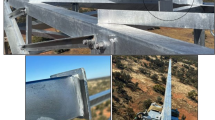Abstract
This study provides a detailed failure analysis of galvanized steel wires (3mm in diameter) for a 35 kV transmission and distribution line, which was carried out by combining the conventional material analysis methods with the finite element method (FEM). It is found that the failed material had good plasticity (5% in elongation), and under the soft torsion loading condition (0.75 in stress state soft coefficient), the ductile fracture should occur on the material. Additionally, the theoretical number of torsions calculated by the FEM was 26.2 times, while the actual number of torsions achieved by the test was only 2.2 times and the local fracture surface exhibited brittle fracture characteristics. The results showed that the local torsion brittle fracture of the material with good plasticity was caused by triaxial stress in the torsion condition, which led to the formation of cavity in the pulling stress area in the material’s center, and the finite element calculation results indicated that the stress state soft coefficient at the cavity was distributed between 0.31 and 0.38, and the stress concentration at the cavity was more than twice the normal value. Besides, the Widmanstatten structure formed as the improper hot working process is the corresponding structural reason.
Similar content being viewed by others
References
ZHANG H, WANG Y F, HE D, et al. Overview of situation, problems and suggestions of disaster prevention and mitigation in power systems [J]. Power System Technology, 2016, 40(9): 2838–2844 (in Chinese).
BELYAEV A, IVANOVSKY R, KARPOV Y, et al. Electrical grid and risk assessment [C]// 4th International Scientific Symposium on Electric Power Engineering. Stara Lesna, Slovakia: Technical University of Kosice, 2007: 612–616.
Standardization Administration of the People’s Republic of China. Zinc-coated steel wires for stranded conductors: GB/T 3428-2012 [S]. Beijing: Standards Press of China, 2012 (in Chinese).
YAO H D, ZHU Y G, XIAO Z R, et al. Influencing factor of drawing steel wire torsion performance [J]. Metal Products, 2015, 41(2): 22–26 (in Chinese).
LI G Z, ZHANG J F, WANG Y Y. Cause analysis affecting torsion property of galvanized steel wire [J]. Steel Wire Products, 2007, 33(5): 5–7 (in Chinese).
CORDIER-ROBERT C, FORFERT B, BOLLE B, et al. Influence of torsion deformation on microstructure of cold-drawn pearlitic steel wire [J]. Journal of Materials Science, 2008, 43(4): 1241–1248.
ATIENZA J M, ELICES M, RUIZ-HERVIAS J, et al. Residual stresses and durability in cold drawn eutectoid steel wires [J]. Metals and Materials International, 2007, 13(2): 139–143.
HU X J, WANG L, FANG F, et al. Origin and mechanism of torsion fracture in cold-drawn pearlitic steel wires [J]. Journal of Materials Science, 2013, 48(16): 5528–5535.
GOES B, MARTIN-MEIZOSO A, GIL-SEVILLANO J, et al. Fragmentation of As-drawn pearlitic steel wires during torsion tests [J]. Engineering Fracture Mechanics, 1998, 60(3): 255–272.
ZHOU J M, LI J C. Effect of axial tension load on twist number of steel wire in torsion test [J]. Physics Examination and Testing, 1992 (4): 50–53 (in Chinese).
ZHAO T Z, ZHANG G L, ZHANG S H, et al. Fracture characteristics of fully pearlitic steel wire in tension and torsion [J]. Journal of Iron and Steel Research International, 2016, 23(11): 1206–1212.
SUZUKI Y, ASAKAWA M, MIZUNO H, et al. Generating a mechanism of delamination in high carbon steel wire by experimental drawing [J]. Wire Journal International, 2005, 38(10): 70–72.
KENICHI S, NOZOMU K. Fracture mechanics aspects of delamination occurrence in high-carbon steel wire [J]. Wire Journal International, 2002, 35(3): 88–97.
GELFI M, SOLAZZI L, POLI S. Influence of the manufacturing process on defects in the galvanized coating of high carbon steel wires [J]. Materials, 2017, 10(3): 264.
VAGGE S T, RAJA V S, NARAYANAN R G. Effect of deformation on the electrochemical behavior of hotdip galvanized steel sheets [J]. Applied Surface Science, 2007, 253(20): 8415–8421.
SINGH J K, SINGH D D N. Studies on defects in galvanized coating on steel wire [J]. Indian Journal of Chemical Technology, 2012, 19(5): 361–365.
Standardization Administration of the People’s Republic of China. Test methods for bare wires—Part 4: Torsion test: GB/T 4909.4—2009 [S]. Beijing: Standards Press of China, 2009 (in Chinese).
XU H Y, ZHANG C H. Finite element analysis of roller bearing based on the plastic material models [J]. Journal of Mechanical Engineering, 2010, 46(11): 29–35 (in Chinese).
WANG X M. Numerical analysis of ANSYS engineering structure [M]. Beijing: China Communications Press, 2007 (in Chinese).
SIMA A P. Influence of stress triaxiality on material fracture [D]. Shanghai: Shanghai Jiao Tong University, 2009 (in Chinese).
HU S Y. Manual of mechanical failure analysis [M]. Chengdu: Sichuan Science and Technology Press, 1989 (in Chinese).
Standardization Administration of the People’s Republic of China. Steel——Determination of microstructure: GB/T 13299-1991 [S]. Beijing: Standards Press of China, 1991 (in Chinese).
LUO S M. Study on key techniques of stranded wire processing [D]. Xi’an: Xi’an University of Architecture and Technology, 2004 (in Chinese).
LEE S K, LEE S B, KIM B M. Process design of multi-stage wet wire drawing for improving the drawing speed for 0.72wt% C steel wire [J]. Journal of Materials Processing Technology, 2010, 210(5): 776–783.
ZELIN M. Microstructure evolution in pearlitic steels during wire drawing [J]. Acta Materialia, 2002, 50(17): 4431–4447.
Acknowledgment
The authors gratefully acknowledge Sichuan Tongyuan Electric Power Technology Company for providing the electronic universal test machine and the metal wire torsion test machine.
Author information
Authors and Affiliations
Corresponding author
Rights and permissions
About this article
Cite this article
Wang, M., Zhang, X., Long, P. et al. Torsion Failure Analysis of Galvanized Steel Wires for Transmission and Distribution Lines Based on ANSYS Numerical Simulation. J. Shanghai Jiaotong Univ. (Sci.) 24, 632–639 (2019). https://doi.org/10.1007/s12204-019-2112-4
Received:
Published:
Issue Date:
DOI: https://doi.org/10.1007/s12204-019-2112-4
Key words
- galvanized steel wire
- torsion brittle fracture
- triaxial stress state
- cavity rupture
- finite element method (FEM)




